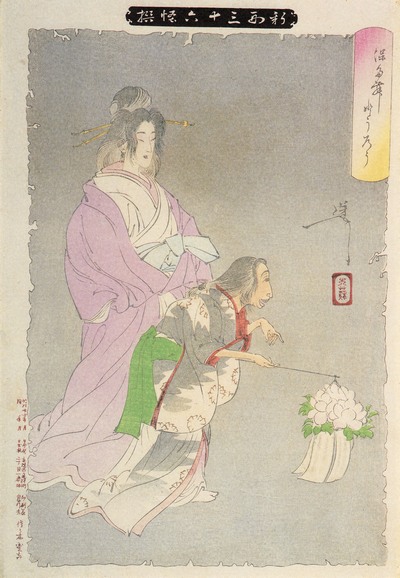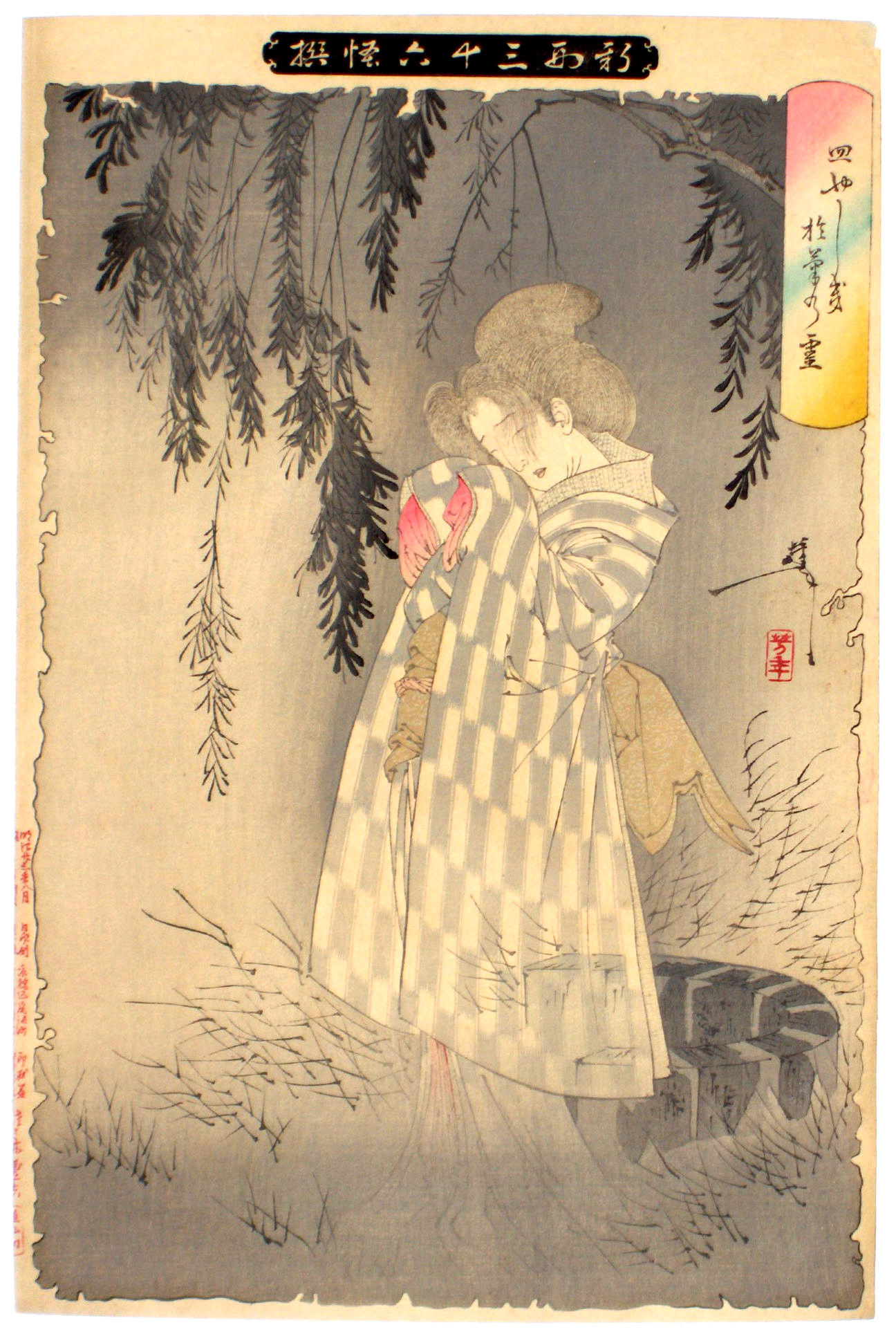|
Kaidan
is a Japanese word consisting of two kanji: 怪 (''kai'') meaning "strange, mysterious, rare, or bewitching apparition" and 談 (''dan'') meaning "talk" or "recited narrative". Overall meaning and usage In its broadest sense, ''kaidan'' refers to any ghost story or horror story, but it has an old-fashioned ring to it that carries the connotation of Edo period Japanese folktales. The term is no longer as widely used in Japanese as it once was: Japanese horror books and films such as '' Ju-on'' and ''Ring'' would more likely be labeled by the ''katakana'' . ''Kaidan'' is only used if the author/director wishes to specifically bring an old-fashioned air into the story. Examples of ''kaidan'' *''Banchō Sarayashiki'' (''The Story of Okiku'') by Okamoto Kido *''Yotsuya Kaidan'' (''Ghost Story of Tōkaidō Yotsuya'') by Tsuruya Nanboku IV (1755–1829) *''Botan Dōrō'' (''The Peony Lantern'') by Asai Ryoi *'' Mimi-nashi Hōichi'' (''Hōichi the Earless'') ''Hyakumonogatari Kaidan ... [...More Info...] [...Related Items...] OR: [Wikipedia] [Google] [Baidu] |
Hyakumonogatari Kaidankai
was a popular didactic Buddhist-inspired parlour game during the Edo period in Japan. Play The game was played as night fell upon the region using three separate rooms. In preparation, participants would light 100 andon in the third room and position a single mirror on the surface of a small table. When the sky was at its darkest, guests gathered in the first of the three rooms, taking turns orating tales of ghoulish encounters and reciting folkloric tales passed on by villagers who claimed to have experienced supernatural encounters. These tales soon became known as kaidan. Upon the end of each kaidan, the story-teller would enter the third room and extinguish one andon, look in the mirror and make their way back to the first room. With each passing tale, the room slowly grew darker and darker as the participants reached the one hundredth tale, creating a safe haven for the evocation of spirits. However, as the game reached the ninety-ninth tale, many participants would stop, ... [...More Info...] [...Related Items...] OR: [Wikipedia] [Google] [Baidu] |
Yotsuya Kaidan
, the story of Oiwa and Tamiya Iemon, is a tale of betrayal, murder and ghostly revenge. Arguably the most famous Japanese ghost story of all time, it has been adapted for film over 30 times and continues to be an influence on Japanese horror today. Written in 1825 by Tsuruya Nanboku IV as a kabuki play, the original title was . It is now generally shortened, and loosely translates as ''Ghost Story of Yotsuya.'' History First staged in July 1825, ''Yotsuya Kaidan'' appeared at the Nakamuraza Theater in Edo (the former name of present-day Tokyo) as a double-feature with the immensely popular '' Kanadehon Chushingura.'' Normally, with a Kabuki double-feature, the first play is staged in its entirety, followed by the second play. However, in the case of ''Yotsuya Kaidan'' it was decided to interweave the two dramas, with a full staging on two days: the first day started with ''Kanadehon Chushingura'' from Act I to Act VI, followed by ''Tōkaidō Yotsuya Kaidan'' from Act I to ... [...More Info...] [...Related Items...] OR: [Wikipedia] [Google] [Baidu] |
Ugetsu Monogatari
is a collection of nine supernatural tales first published in 1776. It is the best known work of Japanese author Ueda Akinari. Largely adapted from traditional Japanese and Chinese ghost stories, the collection is among the most important works of Edo period (1603–1867) and literature, and is considered a predecessor of the genre. Kenji Mizoguchi's award-winning film (1953), credited with helping popularize Japanese cinema in the West, was adapted from two of the collection's stories. Title The word is a compound word; means "rain", while translates to "moon". It derives from a passage in the book's preface describing "a night with a misty moon after the rains", and references a Noh play, also called , which also employs the common contemporary symbols of rain and moon. These images evoked the supernatural and mysterious in East Asian literature; Qu You's (; a story from , one of Ueda's major sources), indicates that a rainy night or a morning moon may presage the comi ... [...More Info...] [...Related Items...] OR: [Wikipedia] [Google] [Baidu] |
Ghost Story
A ghost story is any piece of fiction, or drama, that includes a ghost, or simply takes as a premise the possibility of ghosts or characters' belief in them."Ghost Stories" in Margaret Drabble (ed.), ''Oxford Companion to English Literature''. Oxford, Oxford University Press, 2006. (p. 404-5). The "ghost" may appear of its own accord or be summoned by magic. Linked to the ghost is the idea of a "haunting", where a supernatural entity is tied to a place, object or person. Ghost stories are commonly examples of ghostlore. Colloquially, the term "ghost story" can refer to any kind of scary story. In a narrower sense, the ghost story has been developed as a short story format, within genre fiction. It is a form of supernatural fiction and specifically of weird fiction, and is often a horror story. While ghost stories are often explicitly meant to scare, they have been written to serve all sorts of purposes, from comedy to morality tales. Ghosts often appear in the narrative as s ... [...More Info...] [...Related Items...] OR: [Wikipedia] [Google] [Baidu] |
Ghost Story
A ghost story is any piece of fiction, or drama, that includes a ghost, or simply takes as a premise the possibility of ghosts or characters' belief in them."Ghost Stories" in Margaret Drabble (ed.), ''Oxford Companion to English Literature''. Oxford, Oxford University Press, 2006. (p. 404-5). The "ghost" may appear of its own accord or be summoned by magic. Linked to the ghost is the idea of a "haunting", where a supernatural entity is tied to a place, object or person. Ghost stories are commonly examples of ghostlore. Colloquially, the term "ghost story" can refer to any kind of scary story. In a narrower sense, the ghost story has been developed as a short story format, within genre fiction. It is a form of supernatural fiction and specifically of weird fiction, and is often a horror story. While ghost stories are often explicitly meant to scare, they have been written to serve all sorts of purposes, from comedy to morality tales. Ghosts often appear in the narrative as s ... [...More Info...] [...Related Items...] OR: [Wikipedia] [Google] [Baidu] |
Botan Dōrō
is a Japanese ghost story () and one of the most famous in Japan. The plot involves sex with the dead and the consequences of loving a ghost. It is sometimes known as , based on the kabuki version of the story; this title is commonly used in translation, and refers to a Stone Lantern. History entered Japanese literary culture in the 17th century, through a translation of a book of Chinese ghost stories called (''New Tales Under the Lamplight'') by Qu You. The collection was didactic in nature, containing Buddhist moral lessons on karma. In 1666, author Asai Ryoi responded to the Edo period craze for , spawned largely by the popular game , by adapting the more spectacular tales from into his own book (''Hand Puppets''). At the time, Japan's borders were entirely closed, with very little of the outside world known by its people; as such, China was viewed as a mysterious and exotic nation. Asai removed the Buddhist moral lessons and gave the stories a Japanese setting, ... [...More Info...] [...Related Items...] OR: [Wikipedia] [Google] [Baidu] |
Banchō Sarayashiki
is a Japanese ghost story (kaidan) of broken trust and broken promises, leading to a dismal fate. Alternatively referred to as the tradition, all versions of the tale revolve around a servant, who dies unjustly and returns to haunt the living. Some versions take place in or , others in the area in Edo. History The story of the death of Okiku () first appeared as a bunraku play called ''Banchō Sarayashiki'' in July 1741 at the Toyotakeza theater. The familiar ghost legend had been adapted into a ''ningyō jōruri'' production by Asada Iccho and Tamenaga Tarobei I. Like many successful bunraku shows, a kabuki version followed and in September 1824, ''Banchō Sarayashiki'' was staged at the Naka no Shibai theater starring Otani Tomoemon II and Arashi Koroku IV in the roles of Aoyama Daihachi and Okiku. A one-act kabuki version was created in 1850 by Segawa Joko III, under the title ''Minoriyoshi Kogane no Kikuzuki,'' which debuted at the Nakamura-za theater and starred Ich ... [...More Info...] [...Related Items...] OR: [Wikipedia] [Google] [Baidu] |
Japanese Horror
Japanese horror is horror fiction derived from popular culture in Japan, generally noted for its unique thematic and conventional treatment of the horror genre differing from the traditional Western representation of horror. Japanese horror tends to focus on psychological horror, tension building ( suspense), and supernatural horror, particularly involving ghosts (''yūrei'') and poltergeists. Other Japanese horror fiction contains themes of folk religion such as possession, exorcism, shamanism, precognition, and ''yōkai''. Forms of Japanese horror fiction include artwork, theater, literature, film, anime and video games. Origins The origins of Japanese horror can be traced back to the horror fiction and ghost stories of the Edo period and the Meiji period, which were known as ''kaidan'' (sometimes transliterated ''kwaidan''; literally meaning "strange story"). Elements of these popular folktales have routinely been used in various forms of Japanese horror, especially the tra ... [...More Info...] [...Related Items...] OR: [Wikipedia] [Google] [Baidu] |
Folklore
Folklore is shared by a particular group of people; it encompasses the traditions common to that culture, subculture or group. This includes oral traditions such as tales, legends, proverbs and jokes. They include material culture, ranging from traditional building styles common to the group. Folklore also includes customary lore, taking actions for folk beliefs, the forms and rituals of celebrations such as Christmas and weddings, folk dances and initiation rites. Each one of these, either singly or in combination, is considered a folklore artifact or traditional cultural expression. Just as essential as the form, folklore also encompasses the transmission of these artifacts from one region to another or from one generation to the next. Folklore is not something one can typically gain in a formal school curriculum or study in the fine arts. Instead, these traditions are passed along informally from one individual to another either through verbal instruction or demonstr ... [...More Info...] [...Related Items...] OR: [Wikipedia] [Google] [Baidu] |
Parlour Game
A parlour or parlor game is a group game played indoors using speech (from French Parler). They were often played in a parlour. These games were extremely popular among the upper and middle classes in the United Kingdom and in the United States during the Victorian era. The Victorian age is sometimes considered the "Golden Age" of the parlour game. During the 19th century, the upper and middle classes had more leisure time than people of previous generations. This led to the creation of a variety of parlour games to allow these gentlemen and ladies to amuse themselves at small parties. Boxed parlour games were very popular from around 1920 until into the 1960s, especially around Christmas. Parlour games competed for attention with the mass media, particularly radio, movies, and television. Though decreased in popularity, parlour games continue to be played. Some remain nearly identical to their Victorian ancestors; others have been transformed into board games such as Balderda ... [...More Info...] [...Related Items...] OR: [Wikipedia] [Google] [Baidu] |
China
China, officially the People's Republic of China (PRC), is a country in East Asia. It is the world's most populous country, with a population exceeding 1.4 billion, slightly ahead of India. China spans the equivalent of five time zones and borders fourteen countries by land, the most of any country in the world, tied with Russia. Covering an area of approximately , it is the world's third largest country by total land area. The country consists of 22 provinces, five autonomous regions, four municipalities, and two Special Administrative Regions (Hong Kong and Macau). The national capital is Beijing, and the most populous city and financial center is Shanghai. Modern Chinese trace their origins to a cradle of civilization in the fertile basin of the Yellow River in the North China Plain. The semi-legendary Xia dynasty in the 21st century BCE and the well-attested Shang and Zhou dynasties developed a bureaucratic political system to serve hereditary monarchies, or dyna ... [...More Info...] [...Related Items...] OR: [Wikipedia] [Google] [Baidu] |








